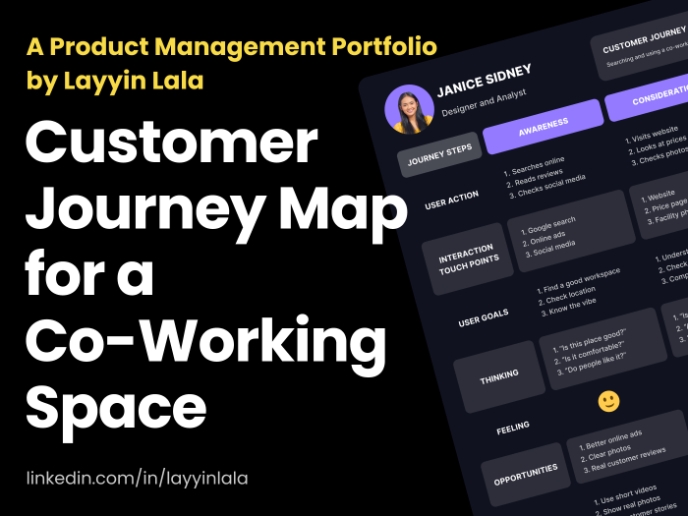Create a Customer Journey Map
Test your ability to identify user pain points and ideate solutions through customer journey mapping.
The scenario
Use the scenario to understand the project context and what you’ll be working on.
You are a service designer tasked with creating a customer journey map for a co-working space that provides an offsite workplace. Competitors include WeWork, Workbar, and CO+HOOTS. The objective of the customer journey map is to identify pain points and opportunities for improvement, to enhance the overall experience, including the online experience, for individuals utilizing co-working facilities.
Details
Your task
Here’s what you need to do for your project:
- Select a co-working service for your design.
- Analyze its competitors.
- Create a user persona profile for this co-working service.
- Develop a customer journey map to illustrate the entire experience.
- Identify areas for improvement and suggest possible next steps.
- Use the provided CJM templates to showcase your designs.
Instructions
Read the instructions to ensure your project receives maximum visibility.
- You can edit your project at any time.
- Remember to share your submission with your community. The more reviews and views it receives, the quicker it will be seen by Uxcel Mentors.
- After submitting your project, consider reviewing others' projects. This can enhance your project's discoverability.
- Ensure you only submit your own work.
Evaluation criteria
Your project will be evaluated using the following criteria:
Templates
Recommended learning
External resources
Topics
Share
Top project submissions

CJM for Co Working Space

Customer Journey Map for a Co-Working Space

Customer Journey Map - Maya
Similar Briefs

Plan A/B Test for the Onboarding Flow

Conduct a Heuristic Analysis

Develop a User Persona
FAQs
Briefs cover a variety of topics aligned with Uxcel’s six core skill categories: UX Research, Visual Design, Interaction Design, Content Strategy, Product Thinking, and Leadership. They include a clear scenario, task, recommended tools, and curated resources to guide your approach. By completing a Brief, you can sharpen your problem-solving skills, grow your portfolio, and receive expert feedback from mentors.
Strong submissions typically go through multiple iterations and demonstrate both problem-solving and attention to detail. You’ll also improve faster by reflecting on mentor feedback, identifying patterns in your mistakes, and applying those lessons to future projects.
When submitting a Brief, you'll upload a showcase image, give your project a name, and write a brief description. For tips on effective submissions, check out our best practices here.
Pro tip: Share your submission with your network to increase visibility and feedback. Our algorithm takes likes and reviews into account when ranking projects on the Showcase page.





















